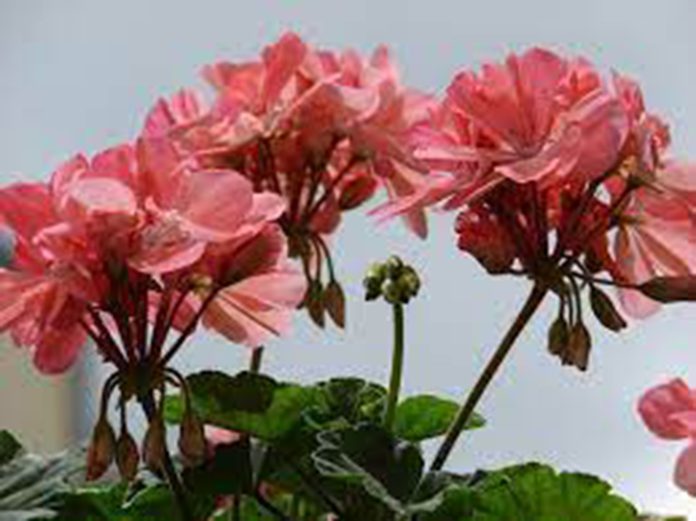Sara Williams, Saskatchewan Perennial Society
My most enduring memory of geraniums (Pelargonium spp.) dates back over 60 years ago to 1963. As a young teacher in Tanzania, East Africa, I was amazed to see geranium hedges of over 6 feet (2 m), not unlike the caragana hedges that form an integral part of prairie shelterbelts. I later learned that this species was one of almost 250, almost all native to South Africa, where they grow in a dry, frost-free environment. Only a few of these species have been used extensively in modern hybridization.
Perennial plants, the botanical name is derived from the Greek word, pelargos for stork. The seed head looks like a stork’s bill. Flowers range from white through pink, salmon and red with many bi-colours. The leaves are palmately lobed and often coloured.
First introduced to European gardens in the early 1600s, they were grown by John Tradescant in Lambeth, London by 1633. They had arrived in Holland via the Dutch East India Company by 1700 and were grown in the Chelsea Physic Garden in England by 1701. Geraniums were often collected by sailors because the tuber was once used in the treatment of dysentery. Hybridization had begun by the 1800s. Geraniums gained great popularity during the Victorian era and were enjoyed by the British royalty.
Widely grown on the Canadian prairies, geraniums are generally grown as annuals: as bedding plants, in containers and in baskets. However, they are actually tender perennials, and if taken indoors before frost, they will live for many years. Once indoors, ensure that they have adequate light (a south-facing window) to prevent spindly growth.
Most of the species commonly grown as house plants have been extensively hybridized, including zonal geraniums (Pelargonium x hortorum) whose attractive leaves are “zoned” into various colours; ivy geraniums (Pelargonium peltatum) with foliage resembling that of ivy; regal geraniums (P. domesticum); and scented geraniums (derived from various species).
Many varieties can be propagated by seeds: in spring, sow indoors in flats about 10 weeks before the last expected frost. Once true leaves appear, move them to two-inch pots and then onto four-inch pots once they are larger. Hybrid varieties will not “come true” from seeds, but these are easily grown from cuttings:
• Bring the plants indoors in the fall before frost.
• Take cuttings in late winter or early spring from the active new growth.
• Cuttings should be about 3-4 inches (8-10 cm) long, taken from vigorous shoots of 15 cm or longer. It’s best to use non-flowering stems.
• Using a sharp knife, make a clean slanted cut just above a node.
• Remove the bottom leaves, allowing three leaves per cutting.
• Let the cut end dry for a day before placing the cuttings in individual 3-inch pots with good drainage. Fill the pots with moist clean sharp sand, vermiculite, perlite or peat moss. Ensure that the cutting is in firm contact with the soil.
• Cover loosely with plastic to retain moisture.
• Place the pots in a warm (70-75°F), moderately humid environment in bright light but out of direct sunlight.
• Do not fertilize.
• Spray lightly with water if they appear dry. Keep them evenly moist but never wet.
• Alternatively, geranium cuttings may be rooted in water and transplanted to a soilless medium once the roots have developed.
• Once roots develop (generally within 3 weeks) at or near the cut surface of the cutting, your new plant is off to the races. Gradually harden these off in terms of light, temperature and humidity.
Sara Williams is the author of many books including Gardening Naturally with Hugh Skinner, Creating the Prairie Xeriscape, and with Bob Bors, Growing Fruit in Northern Gardens. She gives workshops on a wide range of gardening topics throughout the prairies. This column is provided courtesy of the Saskatchewan Perennial Society (SPS; saskperennial@hotmail.com). Check our website (www.saskperennial.ca) or Facebook page (www.facebook.com/saskperennial) for a list of upcoming gardening events.


